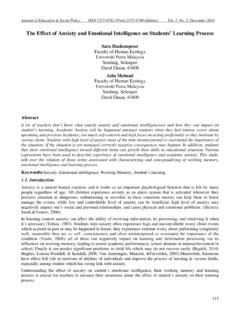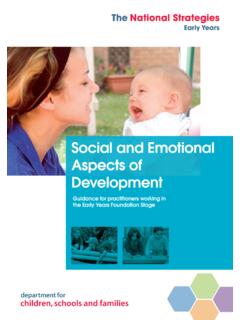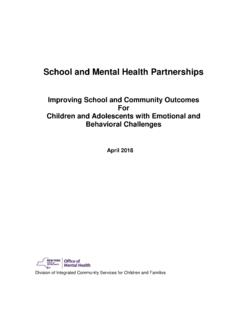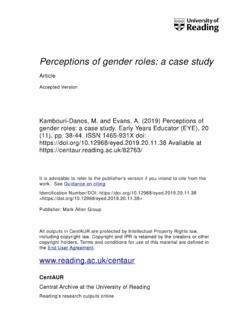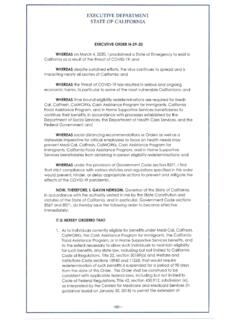Transcription of The Link between Poverty, the Proliferation of Violence ...
1 Forum on Public Policy 1 The link between Poverty, the Proliferation of Violence and the Development of Traumatic Stress Among Urban Youth in the United States to School Violence : a Trauma Informed, social Justice Approach to School Violence Portia D. Rawles, Adjunct Professor, Norfolk State University Abstract This paper presents two premises regarding school Violence in urban America. First, that traumatic stress among urban youth in the United States is a key factor in the development and exacerbation of school Violence in urban areas. Secondly, an efficacious approach to the resolution of school Violence cannot be achieved without addressing this factor.
2 This discourse explores these two premises within the context of two phenomena. The first phenomenon is the development of traumatic stress as a consequence of the lack of social justice in urban areas, which promotes a culture of poverty and subsequent increased exposure to Violence and maltreatment among youth. The second is that such increased exposure to Violence fosters the vulnerability of youth to engage in aggressive and violent behaviors in the school setting. Interrelated concepts of economic inequality, maltreatment and Violence , traumatic stress theory, childhood development, attachment theory and risk and protective factors will be included in this discourse.
3 Introduction social Justice in the most simplistic terms is defined as the concept of justice on a social scale. According to Rawls (1971), within the social justice framework, injustice represents situations in which an individual s freedom or ability to be equal is violated or where fairness is lacking (Coates 2007). Thus, the idea of social justice has evolved to include the ideas of: economic egalitarianism, human rights, and equality of opportunity and outcome. Yet, despite the concept s rich legacy of development and expansion by scholars and politicians, for many in society it continues to be an illusion.
4 This is particularly true in the inner city, urban areas of America. Many of these urban communities, during the early history of the nation were thriving neighborhoods that encompass business, social and cultural opportunities. However, the phenomena of industrialization, the great migration of African Americans from rural Southern communities to Northeastern and Midwest cities, white flight, surbanization, urban renewal and the more recent influx of Spanish-speaking immigrants to these communities due to kinship networks resulted in a synergistic impact of transforming these areas into neighborhoods that mainly contain African Americans and Hispanics (Lamb 2005; Roediger 2005; Reynolds et.)
5 Al. 2001; Wilson 1996; Massey and Denton 1993). These urban areas in America have evolved into communities where the least valued and often most exploited citizens of America dwell and where the denial of social justice; in particularly, economic inequality and inequality of opportunity is the norm. Such circumstances are a reflection of the social system of status, which continues to exist and is legitimatized by the formation of system justifying beliefs (Rawles 2006). Forum on Public Policy 2 The consequence, of this lack of social justice, in urban areas is the propagation of a climate of poverty that engenders an environment of powerlessness, disinvestment and deprivation.
6 Economically disadvantaged youth living in urban areas experience a disproportionate number of inequities, and suboptimal physical, environmental, familial and social conditions in comparison to children with sufficient financial resources (Evans and English 2002). One of the greatest travesties of poverty, for inner city youth is the increased exposure to Violence , as a result of these negative consequences of poverty on the various ecological levels of urban communities. There is a substantial body of literature, which clearly demonstrates that children and adolescents living in poor urban areas experience greater incidences of Violence , whether as witnesses or victims.
7 (Paxton 2004; Okundaye 2004; Self-Brown 2004; Buka et. al. 2001; Mazza and Reynolds 1999; Duncan 1996; Pastore, Fisher and Friedman 1996). Drug trafficking, vacant and dilapidated structures, unemployment, lack of commitment to learning by youth, substandard housing, chaotic, crowded and noisy households, experiences which routinely occur in urban areas have all been linked to the increased occurrence of shootings, murders, sexual assaults, youth Violence , intimate partner Violence , school Violence and child maltreatment (Carpenter and Nevin 2010; Redwood et. al. 2010; Okundaye 2004; Paxton 2004; Evans and English 2002 Pastore, Fisher and Friedman 1996; Duncan 1996).
8 According to the Center for Disease Control and Prevention (2010), school Violence is a subset of youth Violence . School Violence involves harmful behaviors that may start early and continue into young adulthood that occurs on school grounds or on the way to school. It includes bullying, slapping, punching, weapon use and rape. School Violence in American urban areas has over time and under adverse SES conditions, become a fixed phenomenon and continues to be a serious concern for municipal and school officials as well as for community leaders (National Center for Children Exposed to Violence 2006).
9 Despite an overall decline in victimization rates of students ages 12 18, from 1992 2005 nationally; illegal drugs, bullying behavior, weapons and the presence of gangs at school continue to remain a problem (National Center for Education Statistics and Bureau of Justice Statistics 2007). In a later report published in 2009, highlighting school crime and safety statistics from 2007 2008, ten percent of teachers in inner city schools were threatened with injury more often than teachers in town or rural schools. In 2007, ethnic minorities report being more afraid at school or on their way too school (University of Virginia 2007).
10 This finding is not surprising given that ethnic minorities are the majority population of urban areas and school Violence occurs more often in urban schools. It is theorized that urban youth s excessive exposure to Violence , the resulting traumatic stress and its emotional , cognitive, behavioral and social aftermath is a crucial mediating psychological process that is responsible for the ongoing, significant quantity of school Violence in urban areas. This paper explores the role of traumatic stress in school Violence and implications for educational and curriculum based preventative measures.










